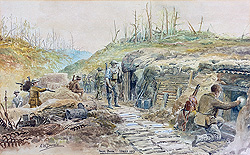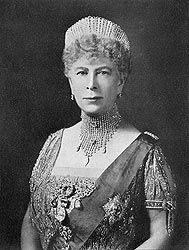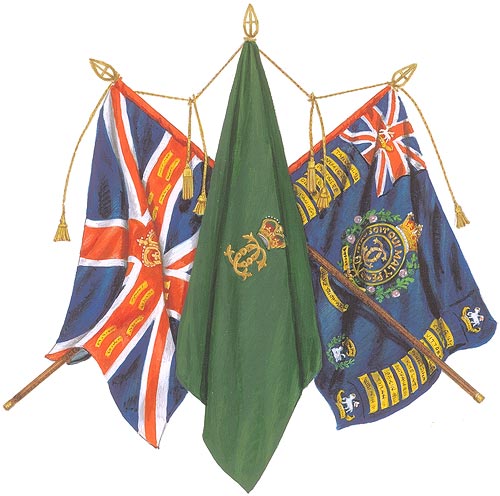 The Queen's in the 1914-1918 War
The Queen's in the 1914-1918 War

When the First World War began on 4th August 1914, the 1st Battalion was in England and the 2nd Battalion in South Africa. The 1st Battalion landed at Le Havre as part of the British Expeditionary Force, while the 2nd Battalion returned to England on l9th September and landed at Zeebrugge as part of 7th Division in early October. Both battalions were up to strength with highly skilled professional soldiers who had maintained the tradition and reputation of the Regiment in every station of the Empire where they had served. For most of them the part played in the slaughter of the next four years was pitifully brief. By the 1st November 1914 during the First Battle of Ypres, there were only 32 survivors of the 1st Battalion and by 7th of that month, the 2nd Battalion also at Ypres, had suffered 676 casualties.
The 1st Battalion was at Mons, the first battle of the war and took part in the retreat, covering 136 miles in thirteen days of hard fighting. After the battles of Mons and the Aisne, it fought the First Battle of Ypres; two days previously on 29th October, it had been joined by the 2nd Battalion withdrawing from Antwerp and that night the two battalions held a sector of the line side by side.
After the battles of Loos in 1915 and the great battle of the Somme in 1916, the 1st Battalion further distinguished itself in 1917 against the Hindenburg Line, at Arras and the Third Battle of Ypres. In 1918 it suffered ‘heavily in the German offensive but held its ground and when the tide turned, it fought its way to victory through the Hindenburg Line. It came out of action on 7th November with only 17 men of all ranks who had landed in France in August 1914.
The 2nd Battalion also lost many men in the slaughter at Ypres in October 1914 and in 1915 it fought the battles of Aubers Ridge, Festubert and Loos. on 1st July 1916 the battalion captured all its objectives in the opening moves of the Battle of the Somme, and with one short rest, fought continuously until 16th July. In 1917, after fighting at Bellecourt, Broodseinde and Passchendaele, it was sent to the Italian front where it added the Battle Honours of Piave and Vittorio Veneto and was at Cavrie when the war ended.
The 4th Battalion, which dates from 1859 when a volunteer company was raised in Croydon, mobilized on 5th August 1914 and in September became the 1st/4th. Reserve battalions as they were raised became 2nd/4th and 3rd/4th. In October 1914 the Home Counties Division, in which the 1st/4th and 1st/5th Battalions of the Queen’s were serving, sailed for India to relieve Regular troops for service in other theatres. The 1st/4th fought on the North-West Frontier in 1916 and 1917 and received a commendation for their conduct and bearing from the Commander-in-Chief.
The 2nd/4th Queen’s, raised in 1914, amalgamated with the 2nd/5th Battalion in 1915 retaining the title of the 2/4th. They joined 53rd Division and sailed in July for Gallipoli where they landed in August, and in subsequent operations fought gallantly to capture and hold Hill 53 on the peninsula. They suffered heavy casualties both from the battles and disease, and in December 1915, when Gallipoli was evacuated, were sent to Egypt where they guarded the Suez Canal until January 1917. After heavy fighting in three attacks on Gaza, the Battalion reached Jerusalem which surrendered on 9th December 1917. In May 1918 the 2/4th was transferred to the Western Front where, after fighting at the Marne, they played a great part in the final offensive.

 |
|
| Ypres 1917. (Click to enlarge) |
|
The 6th Battalion was one of Kitchener’s ‘New Army’ raised in 1914. It went to France in 1915 and fought at the Battle of Loos in 1915, the Somme in 1916 and Arras and Cambrai in 1917. The 7th Battalion went to France in 1915 and made four attacks at the Somme. It suffered appalling casualties at Arras and the Third Battle of Ypres, where Lieut Colonel Bushell, the Commanding Officer, was awarded the Victoria Cross. Finally, the Battalion fought to halt the German offensive in 1918.
The 8th Queen’s suffered heavy casualties at Loos in 1915; they fought at the Somme and the Third Battle of Ypres, and. distinguished themselves in the German offensive of 1918. The 10th and 11th Battalions went to France in 1915 with the 41st Division; they fought at Messines and the Third Battle of Ypres. The Division was moved in 1917 to Italy but returned to France to meet the German offensive of 1918. Six further battalions of the Queen’s fought as part of the London Regiment, and won three Victoria Crosses.
Altogether 31 battalions were raised; the Queen’s fought on nearly every front, added 73 Battle Honours to their Colours and won four Victoria Crosses. The Regimental War Memorial in Holy Trinity Church, Guildford is inscribed: ‘To the glorious memory of 8000 Officers, Warrant Officers, Non-Commissioned officers and Men of the Queen’s who gave their lives for their country in Flanders, France, Italy, Gallipoli, Salonika, Mesopotamia, Palestine, Egypt, India, Africa and Germany 1914-1918’.
The Regiment between the Wars
Between the World Wars the 1st Battalion served in Ireland during ‘the troubles’ and then went to the Far East. After several years in Hong Kong and Tientsin, it moved to Quetta in North West India and was out on a night route march when the city was devastated by the earthquake of 31st May 1935. L/Cpl Henshaw and Pte Brooks were awarded the Empire Gallantry Medal for their work and courage in the subsequent rescue operation. By Royal Command these medals were later converted to the George Cross.
 |
|
| HM Queen Mary Colonel-in-Chief, The Queen's Royal Regiment. (Click to enlarge) |
|
The 2nd Battalion went to India in 1919 where it spent a year on the turbulent North-West Frontier. Under Lieutenant Colonel Mathew-Lannowe, it continued the Regiment’s great reputation for smartness and efficiency, later earning the nickname ‘The Guards of India’ after providing guards and escorts for the Prince of Wales. When it left India in 1926, the Commander-in-Chief, lord Birdwood, said: “For the past 40 years I have realised there are no better troops than The Queen’s.”
The Territorial Battalions which stood down at the end of the Great War, were reactivated in 1920. Initially they were manned by those who had fought in the war. There was a wave of pacifism throughout the country and with no obvious threat in the world, numbers gradually diminished. The 1929 financial crises led to economies with cancelled camps and cuts in training grants.
The rise of the Nazi Party in the mid-1930’s in Germany changed all this; grants were increased and new drill halls and equipment became available which led to an increase of recruits. To give London air defence first consideration, the 4th Battalion (Croydon) became a Searchlight Battalion RE. At the same time 22nd London Regiment became 6th (Bermondsey) Battalion, The Queen’s and 24th London Regiment became the 7th (Southwark) Battalion, The Queen’s; they were both transferred to 44th Home Counties Division and together with the 5th Battalion, 131st Queen’s Brigade was formed.
The Munich crisis in 1938 led to greatly increased activity and training took place every night of the week. Then early in 1939 the Territorial Army was ordered to be doubled and the 2nd/5th, 2nd/6th and 2nd/7th Battalions were formed; after a short period as 35 Brigade, they became 169 Queen’s Brigade of 56th London Division.

The Colours of 1st Battalion The Queen's Royal (West Surrey) Regiment.
Related
